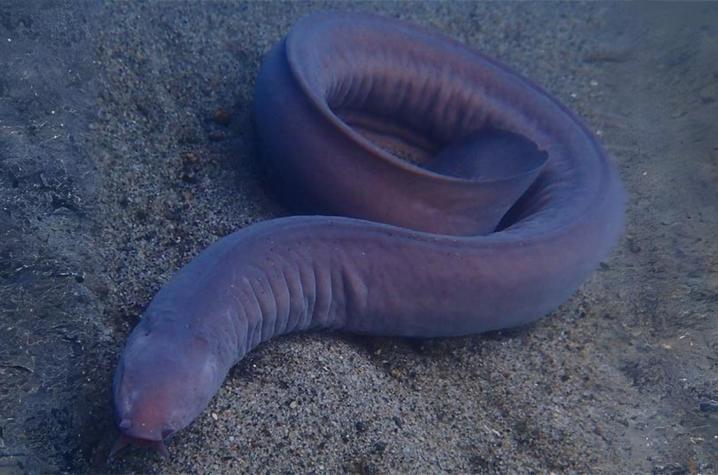
LEXINGTON, Ky. (April 1, 2024) — A study by a group of researchers at the University of Kentucky in collaboration with scientists in four other countries has been published in Nature.
Jeramiah Smith, Ph.D., a professor in the Department of Biology in the College of Arts and Sciences, collaborated with an international research group to parse the hagfish genome and better understand the early evolution of vertebrates.
Their study is “The hagfish genome and the evolution of vertebrates.” Hagfish are a type of jawless fish that live in deep ocean waters far from the light of the sun. They are scavengers that play a role in marine ecosystems. These weird creatures are perhaps best known for their ability to produce huge amounts of slime to protect themselves from predators. Hagfish and lampreys are the only surviving jawless fish.
Their genetic material helped researchers like Smith, along with postdoctoral scholars Nataliya Timoshevskaya, Ph.D., and Vladimir Timoshevskiy, Ph.D., produce a comprehensive picture of vertebrate genome evolution. This work expands upon Smith’s research on the genome of lampreys, funded by the National Institute of Health’s National Institute of General Medical Sciences and the National Science Foundation.
“In this project, we analyzed the genome of the brown hagfish to help resolve some difficult questions about early vertebrate evolution,” Smith said. “We know it was accompanied by a series of ancient polyploidization events — a genetic change where more than the usual two sets of chromosomes end up in cells.”
In looking at the brown hagfish, researchers were able to resolve details of genome duplication events 500 million years ago in jawed and jawless vertebrates.

The team also compared hagfish and lamprey genomes to point out the genetic changes separating the two jawless fish and the biology of hagfish.
“Over time, hagfish lost the genes related to developing organs like eyes and cartilage,” Smith said. “However, we saw hagfish have also expanded a few gene families, including slime-producing genes.”
Because hagfish evolved millions of years ago, Smith said conventional methods to study evolutionary history, or phylogenetics, didn’t give researchers the answers they sought.
“We used the hagfish genome and a new approach focused on chromosome-scale phylogenetics to fully resolve this history of ancient vertebrate polyploidies,” Smith said. “In doing so, we were also able to identify, for the first time, a collection of genes that are also regulated by a natural form of genetic engineering in hagfish ‘programmed DNA elimination’ where some genes are deleted during development.
“Reconstruction of the early genomic history of vertebrates provides a valuable foundation for understanding where most of the genes in humans and other animals came from, and how genomes work in general. This research also further explores the evolution of vertebrates and gives us an opportunity to learn more details about our deep ancestry.”
The study brings together researchers from institutions around the world including:
- University College London in the United Kingdom.
- Okinawa Institute of Science and Technology Graduate University, Shizuoka University and the University of Tokyo in Japan.
- University of Vienna in Austria.
- Agency for Science, Technology and Research in Singapore.
- University of California, Berkeley, and Chan Zuckerberg Biohub in California.
The full study in Nature is also published online.
Research reported in this publication was supported by the National Institute of General Medical Sciences of the National Institutes of Health under Award Number R35GM130349. The content is solely the responsibility of the authors and does not necessarily represent the official views of the National Institutes of Health.
Research reported in this publication was supported by the National Science Foundation under Award Number 1818012. The opinions, findings, and conclusions or recommendations expressed are those of the author(s) and do not necessarily reflect the views of the National Science Foundation.
As the state’s flagship, land-grant institution, the University of Kentucky exists to advance the Commonwealth. We do that by preparing the next generation of leaders — placing students at the heart of everything we do — and transforming the lives of Kentuckians through education, research and creative work, service and health care. We pride ourselves on being a catalyst for breakthroughs and a force for healing, a place where ingenuity unfolds. It's all made possible by our people — visionaries, disruptors and pioneers — who make up 200 academic programs, a $476.5 million research and development enterprise and a world-class medical center, all on one campus.
In 2022, UK was ranked by Forbes as one of the “Best Employers for New Grads” and named a “Diversity Champion” by INSIGHT into Diversity, a testament to our commitment to advance Kentucky and create a community of belonging for everyone. While our mission looks different in many ways than it did in 1865, the vision of service to our Commonwealth and the world remains the same. We are the University for Kentucky.
